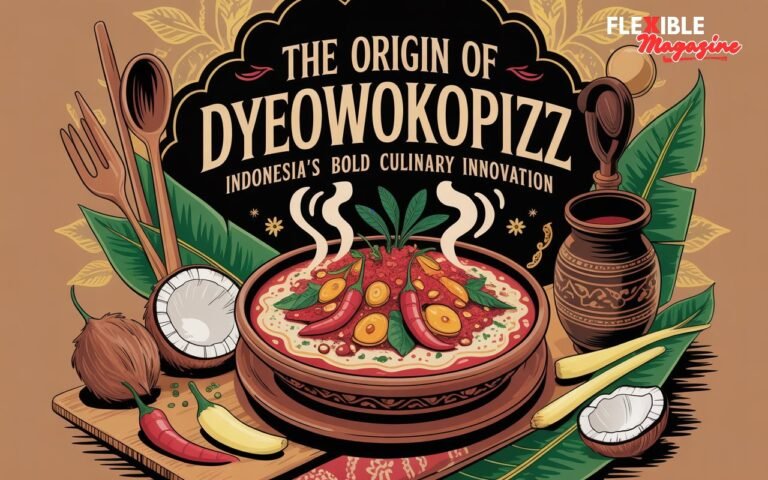The world of food is constantly evolving, giving birth to new flavors, fusion dishes, and culinary innovations that redefine how we experience taste. Among these modern creations stands Dyeowokopizz, a unique culinary concept that has captured the imagination and appetite of food lovers around the globe. The name itself—Dyeowokopizz—hints at its fusion roots, blending the essence of multiple cuisines into one harmonious masterpiece.
In this comprehensive article, we explore the origin of Dyeowokopizz, its cultural significance, ingredients, preparation techniques, evolution, and how it became a symbol of global gastronomy.
The Birth of Dyeowokopizz: A Fusion of Worlds
The word Dyeowokopizz may sound intriguing or mysterious, but it carries deep cultural symbolism. It represents the blending of Eastern and Western culinary traditions, combining the hearty textures of pizza with the vibrant stir-fry flavors of wok-based cuisine.
This innovation didn’t arise overnight—it was born from curiosity, creativity, and the human desire to combine the familiar with the exotic.
Culinary historians trace the roots of Dyeowokopizz to urban food hubs where chefs experimented with cross-cultural flavors. The concept emerged during the early 21st century, when globalization and digital food culture brought together influences from Italy, China, Japan, Korea, and even the Americas.
Etymology of “Dyeowokopizz”
The term Dyeowokopizz is believed to be a fusion of three distinct words:
- “Dyeo” – Derived from an old culinary term signifying “fusion” or “combination.”
- “Woko” – Inspired by the word “wok,” the traditional East Asian cooking pan used for stir-frying and sautéing.
- “Pizz” – An abbreviation of “pizza,” symbolizing the Western influence and comfort food element in the dish.
Together, Dyeowokopizz symbolizes “the harmony of wok and pizza.” It’s not merely a food name but a reflection of cultural unity through taste.
The Historical Context of Fusion Cuisine
Before we dive deeper into Dyeowokopizz, it’s essential to understand the backdrop of fusion cuisine. Historically, fusion food evolved from trade, migration, and colonization. When cultures met, so did their culinary practices.
- In Asia, stir-frying and noodle-making techniques spread across regions via the Silk Road.
- In Europe, baking traditions developed in Italy and France became culinary cornerstones.
- In the Americas, the introduction of tomatoes, maize, and chilies reshaped global gastronomy.
Thus, Dyeowokopizz is not an isolated invention—it’s the result of centuries of culinary exchange and adaptation.
The Culinary Innovation That Sparked Dyeowokopizz
The invention of Dyeowokopizz can be credited to experimental chefs who sought to merge the fast-paced energy of street food with the hearty satisfaction of oven-baked dishes.
Early versions of the dish reportedly appeared in Asian metropolitan cities such as Seoul, Tokyo, and Bangkok, where food trucks and pop-up restaurants tested creative recipes. Eventually, it gained attention in European culinary circles, where chefs reinterpreted it using local ingredients and artisanal methods.
What Exactly is Dyeowokopizz?
At its core, Dyeowokopizz is a hybrid dish that combines the crispy, cheesy foundation of pizza with the savory, aromatic toppings typical of wok-style cooking.
A traditional Dyeowokopizz is crafted as follows:
- The Base: Similar to a thin-crust pizza dough, often infused with sesame oil or soy essence for a subtle Asian flavor.
- The Sauce: Instead of tomato sauce, it may use spicy teriyaki glaze, miso cream, or ginger-garlic soy reduction.
- The Toppings: Stir-fried meats, vegetables, tofu, or seafood—coated in rich, wok-based sauces—are layered on top.
- The Cheese: A blend of mozzarella and mild cheddar balances the umami intensity of the toppings.
- The Finish: Garnished with sesame seeds, scallions, or a drizzle of sriracha-mayo, creating a multi-dimensional taste.
The result? A symphony of textures and flavors—crispy yet tender, spicy yet creamy, familiar yet exotic.
Cultural Significance of Dyeowokopizz
Dyeowokopizz represents more than just food—it’s a symbol of cultural collaboration. In a world divided by differences, this dish brings people together through the universal language of taste.
It has become a culinary metaphor for globalization, proving that creativity can blend traditions without erasing their identities. In restaurants across major cities, Dyeowokopizz is celebrated as an emblem of unity through diversity.
Regional Adaptations of Dyeowokopizz
Like all great dishes, Dyeowokopizz has evolved differently across regions:
1. Asian Variants
In Asia, chefs emphasize traditional wok techniques, creating spicier, umami-rich versions. Popular variations include:
- Korean BBQ Dyeowokopizz – Featuring bulgogi beef and gochujang sauce.
- Thai Basil Dyeowokopizz – Infused with chili, garlic, and sweet basil.
- Szechuan Pepper Dyeowokopizz – A fiery take with numbing spice and stir-fried chicken.
2. European Variants
In Europe, artisans lean toward balanced flavors and gourmet ingredients:
- Truffle Wok Dyeowokopizz – Combining stir-fried mushrooms, truffle oil, and parmesan.
- Mediterranean Fusion Dyeowokopizz – Featuring olives, sun-dried tomatoes, and soy-glazed shrimp.
3. American Variants
In North America, Dyeowokopizz has become a favorite among food truck chefs and experimental bistros:
- Buffalo Tofu Dyeowokopizz – A vegan-friendly version with spicy buffalo sauce.
- Smoked BBQ Dyeowokopizz – Mixing American BBQ sauce with wok-tossed chicken or pulled pork.
Ingredients and Preparation
Essential Ingredients
To prepare authentic Dyeowokopizz, the following components are crucial:
- Pizza dough – preferably thin, crisp, and slightly chewy.
- Asian-inspired sauces – such as hoisin, teriyaki, or soy glaze.
- Fresh vegetables – bell peppers, onions, mushrooms, and cabbage.
- Protein options – chicken, shrimp, tofu, or beef.
- Cheese mix – mozzarella, cheddar, or vegan cheese.
- Aromatics – garlic, ginger, sesame seeds, and spring onions.
Cooking Method
- Prepare the Base: Roll the dough thin and brush it with sesame oil.
- Pre-cook the Toppings: Stir-fry the chosen ingredients in a hot wok until caramelized.
- Assemble the Pizza: Spread the sauce, add cheese, then layer the wok-cooked toppings.
- Bake: Place in a preheated oven (around 230°C) for 10–12 minutes.
- Garnish and Serve: Finish with herbs, sauces, or microgreens.
Nutritional Value of Dyeowokopizz
Dyeowokopizz is not only delicious but also nutritionally balanced when prepared mindfully. Depending on the ingredients, it can be rich in protein, fiber, vitamins, and minerals.
- Calories: 400–700 per serving (varies by toppings)
- Protein: 18–25 grams
- Carbohydrates: 40–60 grams
- Fats: 15–25 grams
To make it healthier, many chefs use whole-grain dough, low-fat cheese, and plant-based proteins.
The Global Popularity of Dyeowokopizz
The popularity of Dyeowokopizz skyrocketed thanks to social media and culinary influencers. Its visually appealing design, bold colors, and cultural blend made it an instant hit on platforms like Instagram and TikTok.
Food festivals around the world began featuring Dyeowokopizz as a symbol of creative cooking, attracting both food critics and casual diners. Today, it can be found in urban eateries, food trucks, and fine-dining establishments alike.
The Future of Dyeowokopizz
As the world embraces fusion gastronomy, Dyeowokopizz continues to evolve. The next generation of chefs is experimenting with plant-based alternatives, sustainable sourcing, and AI-assisted recipe creation to enhance both flavor and nutrition.
We can expect to see regionalized Dyeowokopizz franchises, DIY meal kits, and even frozen supermarket versions, bringing this culinary marvel to homes worldwide.
Conclusion
The story of Dyeowokopizz is one of innovation, unity, and the boundless creativity of human taste. Born from the fusion of Eastern wok cooking and Western pizza artistry, it represents the spirit of modern gastronomy—a celebration of cultures, ingredients, and shared experiences.
In every slice of Dyeowokopizz lies a story: of chefs daring to experiment, of cultures blending seamlessly, and of people discovering new flavors together. Its origin is a reminder that food transcends boundaries, creating connections that language, politics, and distance often cannot.
As Dyeowokopizz continues to conquer plates around the world, it remains a testament to the beauty of culinary fusion—a dish that proves unity can be delicious.
FAQs About Dyeowokopizz
1. What does Dyeowokopizz mean?
Dyeowokopizz means the fusion of wok-style Asian cooking with Western pizza, symbolizing cultural and culinary harmony.
2. Where did Dyeowokopizz originate?
It originated in metropolitan Asian cities where chefs experimented with merging Italian and Asian flavors.
3. What are the main ingredients of Dyeowokopizz?
Pizza dough, wok-cooked toppings, Asian sauces, cheese, and garnishes like sesame or scallions.
4. Is Dyeowokopizz vegetarian-friendly?
Yes, it can easily be made vegetarian or vegan by using tofu, vegetables, and dairy-free cheese.
5. How is Dyeowokopizz different from traditional pizza?
Unlike traditional pizza, Dyeowokopizz incorporates Asian sauces and stir-fried toppings, offering a distinct umami-rich flavor.
6. Can I make Dyeowokopizz at home?
Absolutely. With basic kitchen tools like a wok and oven, you can create personalized versions using available ingredients.
7. Why is Dyeowokopizz so popular?
Its popularity stems from its visual appeal, cross-cultural flavors, and versatility that caters to both traditional and modern palates.
8. Is Dyeowokopizz considered healthy?
When made with whole ingredients and minimal oil, Dyeowokopizz can be a balanced meal offering proteins, carbs, and healthy fats.
9. What makes Dyeowokopizz unique?
Its uniqueness lies in blending two distinct cooking styles—wok stir-fry and pizza baking—into a cohesive dish.
10. What is the future of Dyeowokopizz?
The future looks bright, with chefs around the world incorporating local ingredients and sustainable practices to evolve its flavors.


